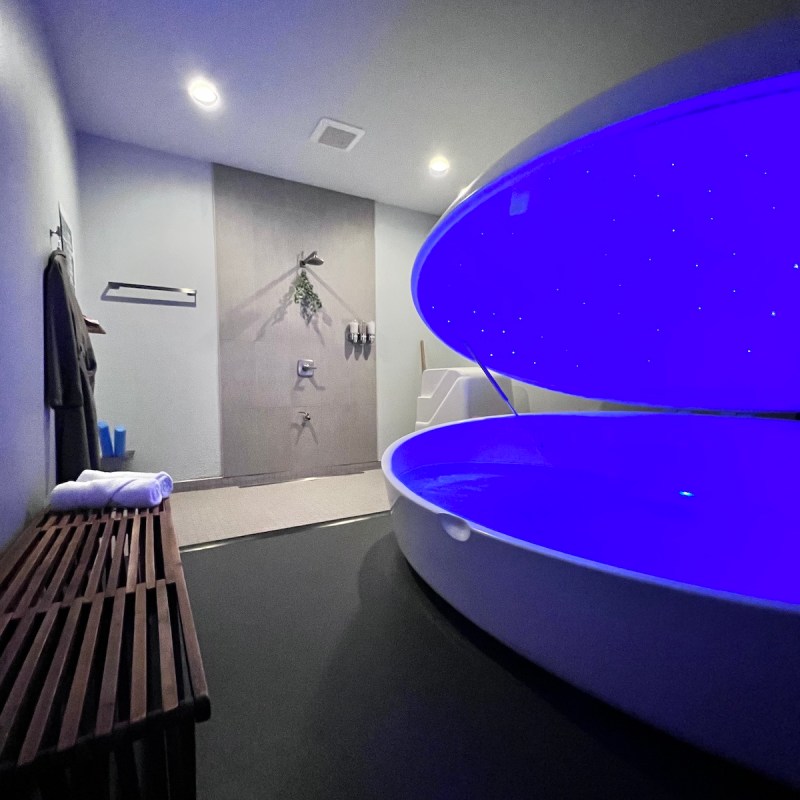
The end of any year is always a time for reflection, and 2022 was no exception. As the scent of freshly baked Christmas cookies gave way to my typical January reality of kale and guilt, I decided that this year, rather than making a list of New Year’s resolutions ultimately discarded by the end of January, I’d jump on the self-care bandwagon.
Videos by TravelAwaits
Enter Relax Lab in Tyler, Texas — East Texas’s first and only float therapy center. Modern float therapy (you may know it as a sensory deprivation tank or isolation tank) has been around since the ’70s. The idea is that deep relaxation can be achieved more efficiently by eliminating the distractions of sight, sound, and even gravity.

What Is A Sensory Deprivation Tank?
The name sensory deprivation tank evokes mild anxiety in me. After all, it sounds a little like something Jason Bourne might be locked in before finally breaking and giving up top-secret information in exchange for his release.
Sensory deprivation tanks, or float tanks, are shallow pools of water in an enclosed, sound-proof space that allow users to spend time without hearing or seeing anything. The water inside a tank has close to 1,000 pounds of dissolved Epsom salt added. That’s enough to simulate Dead Sea buoyancy, allowing effortless flotation. In fact, it’s impossible not to float — and with water that’s kept at 94.5 degrees — the skin’s temperature — it feels like you’re not touching anything, either.
Benefits Of A Sensory Deprivation Tank
Studies suggest that time spent floating in a sensory deprivation tank may have some benefits for healthy people, such as muscle relaxation, better sleep, decreased pain, and decreased stress and anxiety.
Staffers at Relax Lab say that floating can also be a safe place to decompress and allow meaningful personal discovery to occur. In addition to these benefits, habitual floating will enable people to develop a type of “body memory” that promotes energy and well-being — something they can take into their daily life and that can even offer some relief for those with PTSD.
I was just hoping for a relaxing way to start the new year and maybe some relief from a nagging pain that recently manifested in my lower back.

Preparing For My Float In The Sensory Deprivation Tank
Thirty, 60, and 90-minute sessions are offered at Relax Lab. I split the difference and go for the sixty-minute session, slightly skeptical about an entire hour in total darkness. I’m not normally claustrophobic, but I’ve never been enclosed in a small, dark space for an hour. Floating. In silence.
Slipping off my shoes, I place them in a bin and take in my surroundings. An herbal tea bar flanks the long hallway, and soft music plays in the background — it’s a very serene, spa-like atmosphere.
I’m ushered into a room containing the sensory deprivation tank I’ll use — the Orb. Not at all the slightly scary image the words sensory deprivation tank had conjured up in my mind. The Orb is a sleek, white pod lit with blue LED lights. There is even a starlit ceiling.
I’ll need to shower and shampoo before and after the float to prevent cosmetic residue; there’s no conditioner beforehand. I’m handed a cotton robe and earplugs and shown how to operate the controls in the orb.
Editor’s Note: While earplugs can help you have an even quieter experience and keep water out of your ears, wearing them is not necessary. Some floaters find them distracting. If you prefer to swim without earplugs, you may prefer to skip them when you float as well.

The Sensory Deprivation Tank Experience
Naked as the day I was born, I slip into the water and slowly pull the lid closed. The water temp is a surprise. I had imagined it being warmer — similar to a hot tub. The lights, and the stars, even soft music, are all on as I lie back. Users control the experience at all times and can adjust lighting and sound, and even the float length. To ease myself into the experience, I turn off the lights but leave the overhead stars on.
It’s not claustrophobia-inducing at all. The orb is spacious. I’m a hair under 6 feet tall and have plenty of room. I can even sit up without fear of bumping my head.
I squirm around for a bit, not because I’m anxious; it just feels so strange — but in a good way. I have been SCUBA diving before and thought the sensation might be similar, but it’s not. While both experiences promise weightlessness, SCUBA requires a lot of equipment. Tanks, weight belts, respirators, and typically a wet suit. In the tank, it’s just me.
I want to try all the iterations available. So, after a while, I turn off the music, slowly dimming the stars until I am in total darkness. Pitch black, with only the sound of my breath, suspended over the water with zero effort. I resolve to be still and meditate, acknowledging my thoughts as they pass through my mind. I’m unaware of where the water ends and my body begins. Suspended in space and seemingly in time.

Post Float
Music starts playing so softly that it registers as little more than a vibration. Gradually, it becomes louder as the lights turn back on. I’m flabbergasted. There is no way that I’ve been floating for an hour. Stepping out of the orb, a glance at my watch confirms it’s true.
Rinsing off, I notice that the slight ache in my lower back is gone. I feel great — like I’ve had a power nap. Placing my clothes in the tote bag Relax Lab supplied, I slip on the provided robe and head to the blow dry bar, which is filled with products to help get me ready to return to the world. After drying off, I notice that my skin feels fantastic — an unexpected bonus. I leave feeling refreshed and light as air.
I go through the rest of my day feeling great — blissed out and unperturbed, even by the horrific rush hour traffic. I get a great night’s sleep, and two days later, my back feels better than it has in a while.
The Verdict
Would I do it again? You bet! It’s a busy world, and many of us multi-task through it, experiencing sensory overload daily. As we move throughout our days, we are constantly bombarded by sights and sounds. The float forced me to slow down and focus on the here and now. To hit the reset button.
For more on self-care, consider
